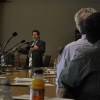Over the past 25 years, California ReLeaf has been assisted, led, and championed by many incredible people. At the beginning of 2014, Amelia Oliver interviewed many of those people who made the most impact during California ReLeaf’s early years.

Andy Lipkis
Founder and President, TreePeople
TreePeople started their work in 1970 and incorporated as a nonprofit in 1973.
What is/was your relationship to ReLeaf?
My relationship with California ReLeaf started when I met Isabel Wade in 1970. Isabel was interested in community-based urban forestry and she and I started pulling stuff together. We attended the 1978 National Urban Forest Conference in Washington DC and opened up conversation with others around the nation about community and citizen forestry. We continued to gather information on how this could work in California. We were inspired by some of the original visionaries, such as Harry Johnson, who supported the need for urban trees.
Fast forward to 1986/87: Isabel was really inspired about California having a statewide organization. Initially the idea was that TreePeople host this, because in 1987 we were the largest such organization in the state, but it was decided that ReLeaf should be a stand-alone entity. So, the young urban forest groups got together and shared ideas. I would love to have a reunion of these creative visionaries. California ReLeaf formed in 1989 with Isabel Wade as the founder.
The 1990 Bush Farm Bill came at a perfect time. This was the first time that the federal government funded Urban Forestry and that the role of community forestry was recognized. This Bill required that every state have an Urban Forest Coordinator and an Urban Forestry Volunteer Coordinator as well as an advisory council. It pushed money into the state (through the Department of Forestry) that would go to community groups. Since California already had the most robust Urban Forest network (ReLeaf) in the country, it was selected to be the Volunteer Coordinator. This was a gigantic leap for California ReLeaf. ReLeaf continued to grow over the years as it mentored other groups and offered pass-through grants to its member organizations.
The next big step for ReLeaf was the evolution into an organization that was generating and influencing public policy rather than solely a support group. This grew out the tension between government, which controlled the money, and the Network’s ability to influence decisions on how or how much public money was spent toward Urban Forestry. Urban Forestry was still such a new phenomenon and decision-makers didn’t seem to understand it. Through a generous partnership with TreePeople, ReLeaf was able to develop their collective voice and learned how they can educate decision makers and leverage Urban Forestry policy.
What did/does California ReLeaf mean to you?
Personally, looking back at ReLeaf over the past years – I see this in relationship to TreePeople. TreePeople is now a 40-year-old organization and has developed a theme of ‘mentorship’. Then there is California ReLeaf; at 25 they seem so young and vibrant. I also feel a personal connection to ReLeaf. The work I accomplished with the 1990 Farm Bill really kick-started urban forestry in California and opened the door for ReLeaf. It’s like an uncle to child relationship, really, that I feel with ReLeaf. I feel connected and get to enjoy watching them grow. I know they are not going to go away.
Best memory or event of California ReLeaf?
My favorite memories of ReLeaf are in those first years. We were inspired young leaders coming together to figure out what we were going to do. We were so excited about the funding for urban forestry coming to California, but it was a struggle, trying to find our footing within the relationship with the California Department of Forestry. Urban Forestry was such a new and revolutionary idea and the result was a continual paradigm battle about who was leading Urban Forestry in California. Through persistence and action, ReLeaf and the urban forestry movement in California have grown and flourished. It was the positive impact of the magnitude.
Why is it important that California ReLeaf continue its Mission?
California ReLeaf is in place supporting groups all over the state, and we know it will continue to be there. It is encouraging that the ReLeaf paradigm offers a new model of infrastructure for how we deal with our world. We need to move away from the old grey engineered solutions to urban problems to ones that mimic nature, ones that use green infrastructure, such as trees to deliver ecosystem services. ReLeaf is a codified structure that is in place to keep that going. As it has adapted over the years, it will keep adapting to meet the needs of the Network. It’s alive and growing.
